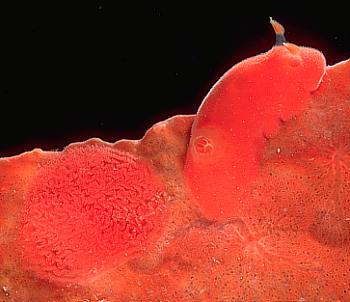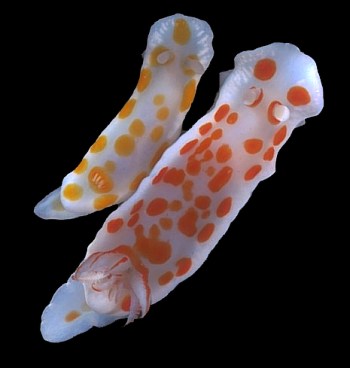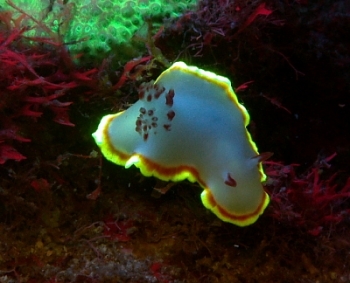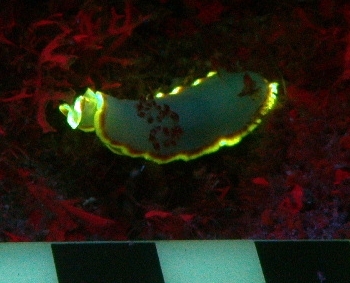

Colour in sea slugs
PHOTO
Upper: Rostanga bifurcata, (25mm long) with egg ribbon, on food sponge, Antho chartacea, AM C150065, Kurnell, Botany Bay, Sydney, May 1986. Lower: Chromodoris tasmaniensis, New South Wales colour form - Jibbon Head, Port Hacking, NSW, 20m, October, 1981, 21, 28mm long alive. Photos: Bill Rudman.
Sea slugs, especially the nudibranchs, are reknowned for their spectacular colour patterns but not all sea slugs are brightly coloured, and those that aren't should be equally famous for their amazing ability to disguise their presence with patterns, and precise colour, which accurately match the plants and animals colonies on which they live.
Have a look at the pages on Defence - Colour patterns, and Camouflage for further information on why colour is so important to sea slugs.
The very precise colour matches we find between many camouflaged sea slugs and their food is no coincidence. In most cases the slugs re-use the colour pigments of their food by incorporating them in their skin. A good example of this are species of the dorid genus Rostanga, such as Rostanga arbutus and Rostanga bifurcata which take the red pigments from their sponge food and incorporate in their skins, and apparently their eggs as well.
Another way of matching their colour with their food is found in the many spcies which have colourless, essentially transparent, skins. In these animals the gut often branches throughout the body cavity and in some cases through the the skin as well. The colour of their food then, becomes the colour of the slug. In special cases, such as the aeolid Favorinus, which feeds on other sea slug eggs, the colour of the slug is therefore dependent on the colour of the eggs it is eating.
Many of the sacoglossans, like Stiliger smaragdinus, get their colouring from the algal pigments they ingest, and the solar-powered nudibranchs which retain unicellular plants in their tissues are coloured by those plants.
Despite this widespread reliance on other plant and animal pigments, the majority of opisthobranchs manufacture their own pigments. A good example of this are the chromodorids which apparently generate the pigments which make their spectacular colour patterns.
Authorship detailsRudman, W.B., 2004 (July 25) Colour in sea slugs. [In] Sea Slug Forum. Australian Museum, Sydney. Available from http://www.seaslugforum.net/find/colour
Related messages
More on flourescence
August 13, 2007
From: Alicia Hermosillo

Dear Bill,
Continuing with the flourescence [message #20387 ], here is a link that some people might find interesting:
http://www.nightsea.com/history.htm
It is true that there is very little information on why some nudibranchs have it and some not, but I believe it to be a very useful complementary tool that helps finding species that are otherwise hard to find.
Here is a photo I thought you might enjoy of Glossodoris sedna. Note the flourescence of the Porites coral [upper left of top photo]. The red surrounding the animal is algae which in daylight is brown.
Locality: Socorro Island, Revillagigedo Archipielago, 65 feet, Colima, Mexico, Tropical eastern Pacific, 12 April 2007, Rocky subtidal. Length: 32 mm. Photographer: Ali Hermosillo.
Cheers!
Alicia
gueri25@hotmail.com
Hermosillo, A., 2007 (Aug 13) More on flourescence. [Message in] Sea Slug Forum. Australian Museum, Sydney. Available from http://www.seaslugforum.net/find/20431
Thanks Ali,
It is certainly a spectacular tool
Best wishes,
Bill Rudman
Re: How do sea slugs make their colour?
August 5, 2006
From: Janine Cindy M. Santiago
Concerning message #17217:
Greetings!
Cindy Santiago here again. I just want to ask if sea slugs have fluorescent proteins?. If yes, where can we locate them in their body?
Thanks and hoping for your reply soon.
Cindy Santiago
Philippine Science High School
jcs_128@yahoo.com
Santiago, J.C., 2006 (Aug 5) Re: How do sea slugs make their colour?. [Message in] Sea Slug Forum. Australian Museum, Sydney. Available from http://www.seaslugforum.net/find/17275Dear Janine,
I think you mean luminescence rather than fluorescence. Flourescence is a phenomenon in which objects glow when they absorb ultraviolet light. I think some parrots' feathers do this. Quite a few animals glow through chemical reactions occurring in their bodies or from chemical reactions occurring in microorganisms that live in their bodies. We normally call this bioluminescence.
There is a page on the Forum on Bioluminescence in nudibranchs but I am afraid it doesn't have much information. The only group I know of are the polycerid genus Plocamopherus. If you look on the Fact Sheet for Plocamopherus imperialis I have included a photo and a description of how this animal can make flashes of light. Unfortunately I have no idea how it does it, and I am pretty sure no research has been done on this.
Best wishes,
Bill Rudman
How do sea slugs make their colour?
July 28, 2006
From: Janine C. Santiago
I'm a senior student in the Philippines.
I'm curious and i wanna know what specific gland or organ of the sea slug produce their color pigment. I know they adopt the color of their food. but I wana know what other ways they produce their color pigment..
hope i can here your answer soon..,
Cindy Santiaago
Quezon City,
Philippines
jcs_128@yahoo.com
Santiago, J.C., 2006 (Jul 28) How do sea slugs make their colour?. [Message in] Sea Slug Forum. Australian Museum, Sydney. Available from http://www.seaslugforum.net/find/17217Dear Janine,
Have a look at the Fact Sheet on 'colour in nudibranchs' and the links on that page to other aspects of the topic. Not all sea slugs adopt the colour of their food, and even those that do don't all do it the same way. Some are relatively transparent so you can see the colour of their food inside their bodies after they have eaten, while othrrs take the actual colour pigments out of their food and move the pigment to cells in their skin.
And then there are the many sea slugs which are very brightly coloured and look nothing like their food. In these cases the nudibranch's colour is from special pigment cells in the skin. This is the way most animals, including humans, produce their colour. [Because we use English not USA spelling, if you want to do a search on the Forum for information on colour you will need to spell it colour not color ].
Good luck with your studies
Best wishes,
Bill Rudman
